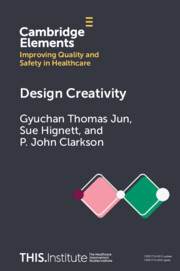336 results

Design Creativity
-
- Published online:
- 04 June 2024
- Print publication:
- 27 June 2024
-
- Element
-
- You have access
- Open access
- HTML
- Export citation
Bridging the gap from medical to psychological safety assessment: consensus study in a digital mental health context
-
- Journal:
- BJPsych Open / Volume 10 / Issue 4 / July 2024
- Published online by Cambridge University Press:
- 03 June 2024, e126
-
- Article
-
- You have access
- Open access
- HTML
- Export citation
The “Safe and Sustainable by Design” Concept – A Regulatory Approach for a More Sustainable Circular Economy in the European Union?
-
- Journal:
- European Journal of Risk Regulation , First View
- Published online by Cambridge University Press:
- 08 May 2024, pp. 1-18
-
- Article
-
- You have access
- Open access
- HTML
- Export citation
Closing the gap between acceptable and ideal in catheterisation for paediatric and congenital heart disease—A global view
-
- Journal:
- Cardiology in the Young , First View
- Published online by Cambridge University Press:
- 03 May 2024, pp. 1-8
-
- Article
-
- You have access
- Open access
- HTML
- Export citation
Chapter 15 - Psychological Approaches to the Acute Patient in PICUs
-
-
- Book:
- Psychiatric Intensive Care
- Published online:
- 15 March 2024
- Print publication:
- 28 March 2024, pp 187-204
-
- Chapter
- Export citation
Chapter 20 - The Practice of Restraint and Physical Intervention
-
-
- Book:
- Psychiatric Intensive Care
- Published online:
- 15 March 2024
- Print publication:
- 28 March 2024, pp 259-267
-
- Chapter
- Export citation
14 - Alerts!
- from Part II - Essential Signs
-
- Book:
- Chinese Signs
- Published online:
- 29 February 2024
- Print publication:
- 07 March 2024, pp 128-137
-
- Chapter
- Export citation
Chapter 43 - The Role of Occupational Health Services and Responding to Staff Who Have Long COVID
- from Section 5 - Sustaining and Caring for Staff During Emergencies
-
-
- Book:
- Major Incidents, Pandemics and Mental Health
- Published online:
- 11 January 2024
- Print publication:
- 01 February 2024, pp 320-325
-
- Chapter
- Export citation
Aflatoxin B1 Sorption and Safety of Dietary Sodium Bentonite in Sprague-Dawley Rats
-
- Journal:
- Clays and Clay Minerals / Volume 70 / Issue 2 / April 2022
- Published online by Cambridge University Press:
- 01 January 2024, pp. 165-181
-
- Article
- Export citation
Visibility and exploitation in social networks
-
- Journal:
- Mathematical Structures in Computer Science , First View
- Published online by Cambridge University Press:
- 19 December 2023, pp. 1-30
-
- Article
-
- You have access
- Open access
- HTML
- Export citation
8 - “Credible Threat” – School Safety Case Study
-
- Book:
- Understanding the Role of Equity
- Published online:
- 12 October 2023
- Print publication:
- 26 October 2023, pp 89-98
-
- Chapter
- Export citation
Effect of next-step antidepressant treatment on suicidal ideation: findings from the VAST-D trial
-
- Journal:
- Psychological Medicine / Volume 54 / Issue 6 / April 2024
- Published online by Cambridge University Press:
- 20 October 2023, pp. 1172-1183
-
- Article
- Export citation
Predicting risk factors for pediatric mortality in clinical trial research: A retrospective, cross-sectional study using a Healthcare Cost and Utilization Project database
-
- Journal:
- Journal of Clinical and Translational Science / Volume 7 / Issue 1 / 2023
- Published online by Cambridge University Press:
- 22 September 2023, e211
-
- Article
-
- You have access
- Open access
- HTML
- Export citation
Immunogenicity and safety of COVID-19 vaccines among people living with HIV: A systematic review and meta-analysis
-
- Journal:
- Epidemiology & Infection / Volume 151 / 2023
- Published online by Cambridge University Press:
- 14 September 2023, e176
-
- Article
-
- You have access
- Open access
- HTML
- Export citation
A Defense of Explanationism against Recent Objections
-
- Journal:
- Episteme , First View
- Published online by Cambridge University Press:
- 04 September 2023, pp. 1-12
-
- Article
-
- You have access
- Open access
- HTML
- Export citation
Chapter 40 - Verification of Specimen Identity by Double Checking with a Witness
- from Section 9 - Quality Management
-
-
- Book:
- Principles of IVF Laboratory Practice
- Published online:
- 07 August 2023
- Print publication:
- 24 August 2023, pp 293-300
-
- Chapter
- Export citation
Investigating the impact of adjunctive priming repetitive transcranial magnetic stimulation in late-life depression: a pilot single-blind randomized control study
-
- Journal:
- CNS Spectrums / Volume 29 / Issue 1 / February 2024
- Published online by Cambridge University Press:
- 11 August 2023, pp. 76-82
-
- Article
- Export citation
Dilatation Eustachian tuboplasty with a Eustachian tube video endoscope and supporting balloon
-
- Journal:
- The Journal of Laryngology & Otology / Volume 138 / Issue 3 / March 2024
- Published online by Cambridge University Press:
- 26 July 2023, pp. 246-252
- Print publication:
- March 2024
-
- Article
-
- You have access
- Open access
- HTML
- Export citation
Security Professionals’ Perceptions of Crime at the Oliver Reginald Tambo International Airport: Towards Sustainable Solutions
-
- Journal:
- International Annals of Criminology / Volume 61 / Issue 2 / June 2023
- Published online by Cambridge University Press:
- 21 June 2023, pp. 131-146
- Print publication:
- June 2023
-
- Article
- Export citation



